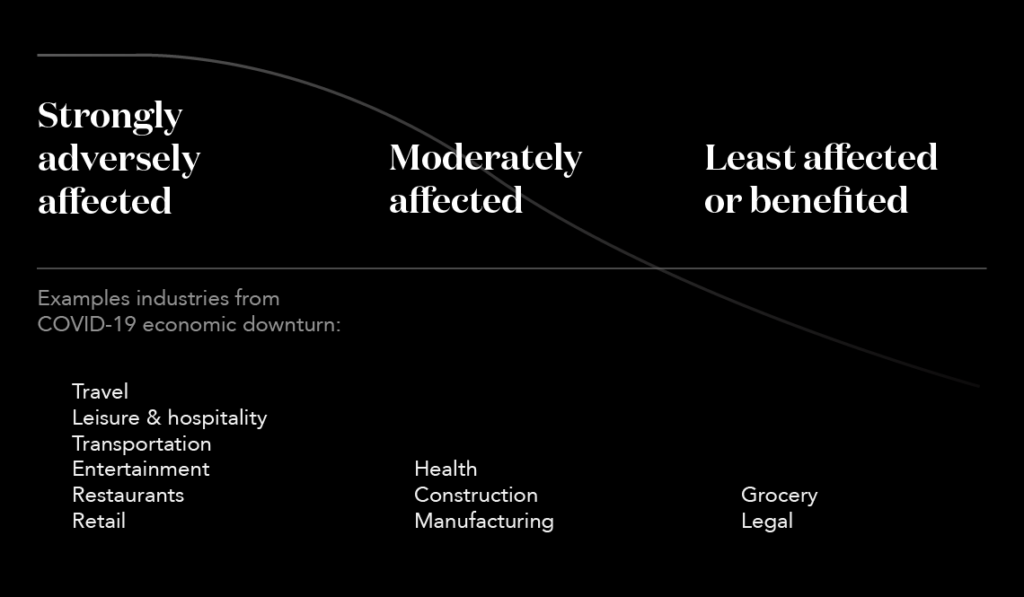Like most of us, your clients are in uncharted territory. COVID-19 has turned life as they know it upside down. They’re nervous and uncertain about how to move their businesses forward — and competitors are taking advantage, dangling special offers and lower-cost alternatives to lure them away.
“We must change our mindset from
winning more to losing less.”
This is now an “all hands on deck” situation, and Marketing is uniquely positioned to support these efforts in a variety of ways — both directly and indirectly. And it starts where it always starts — by knowing your customer.
Enter account-based marketing.
Account-Based Marketing (ABM) has been center stage for a few years now. It involves targeting specific audiences based on known characteristics to deliver highly relevant, personalized content. The more targeted, personal and relevant your content, the more engaged your audience will be.
Marrying meaningful insights with a rock-solid ABM approach is the key to keeping your most important and/or at-risk customers close.
So even if you’re new to ABM, now is a great time to dive in — starting with your existing customers.
Here are a few steps to get your ABM program off the ground.
1. Align with other relationship stakeholders.
Trust me — you don’t want to launch an ABM campaign only to find out that other groups in your organization have also been sending that very same audience communications. Nobody has time for that.
This is especially true if those communications are duplicative, strategically misaligned, or — worse — contradictory to your efforts. It’s the quickest way to overwhelm recipients, get flagged as spam, or have your carefully crafted campaign simply disappear in a sea of noise.
Take time to identify all internal stakeholders who are responsible for client communications. And plan for any initiatives that you develop to seamlessly align with other relationship management activities in cadence, tone and messaging.
So, talk to your internal stakeholders (client services and sales teams) to get buy-in and identify specific opportunities for your marketing team to help create high-value touchpoints with key clients.
2. Segment and prioritize your customers.
Next, determine the criteria for creating your target list(s). Which subset of customers will make the biggest impact? Your biggest clients — or maybe those that may be most at-risk? Make sure there’s a clear understanding of who they are and why they’re on the list.
Use both primary insights — those gained from direct knowledge and interactions — as well as secondary research, such as social listening tools to monitor social media for keywords that may indicate a need. You need to find out what your customers are really thinking, saying and doing as quickly as possible in order to have meaningful conversations with them.

By understanding these patterns, you’ll be better equipped to segment your audiences accordingly and develop a customized engagement plan for each group. Segment your clients based on their level of industry risk and susceptibility to the crisis. Aim for three (3) distinct segments: 1) those strongly adversely affected; 2) those moderately affected; and 3) those unaffected or possibly even benefited by the situation (surprisingly, you may have a few clients in this category). Have vertical experts and analysts do research to uncover important insights to better understand how and why clients might be impacted. Don’t forget competitive research — a quick matrix may tell you all you need to know about how an industry is responding.
3. Plan your program.
Now that you’ve segmented, go back to your other internal relationship stakeholders to collaborate. What insights can they share to help you develop the right programs across the right channels? Are there already customer touchpoints such as newsletters, billing communications, or quarterly business reviews that can be utilized or repurposed? This is a continuation of your earlier conversations, but with a little more focus because you now have a prioritized list.
Once you’ve planned out your channels and tactics, think about messaging and tone. Make sure you avoid common mistakes and follow best practices wherever available, including:
- Beware of the oversell: Now is not the time to push hard, appear opportunistic, or incite panic. Instead, focus on the value you can bring customers and align your messaging to the real concerns you gleaned through primary and secondary research.
- Don’t default to digital as your first touchpoint: Empower account leadership teams to call clients and check in and discuss the current situation. Then, work to offer industry insights and the team’s best thinking to present ideas to mitigate specific risks and/or ideas to surface unique opportunities.
- Account for feedback: Pick 2–3 activities you can track that will give you the best feedback. Focus on those activities and stagger out engagements to relay feedback from early meetings across your team to improve later ones.
Customer-focused ABM pays off today and tomorrow.
In (now mostly virtual) boardrooms across the country, marketing teams are struggling with the question, “Now what?” The simplest answer is that we revise our priorities and pay more attention to our customer base than ever before.
If done right — delivering truly impactful experiences that connect with clients on a personal level — not only will we make it through this crisis, we’ll come out of it with the strongest and most vocal customer advocates we’ve ever seen. That will be our first and best step on the path back to growth.







